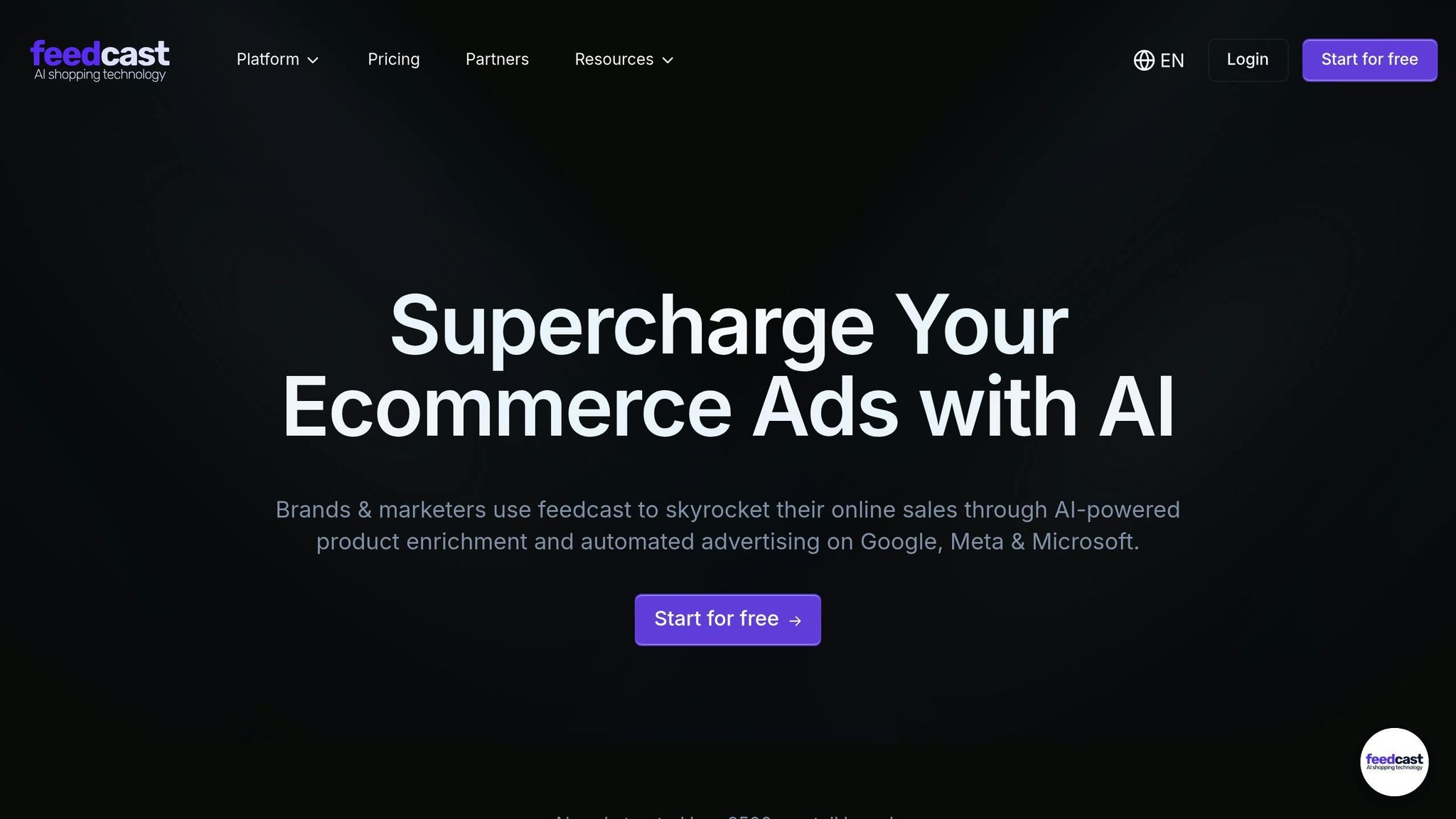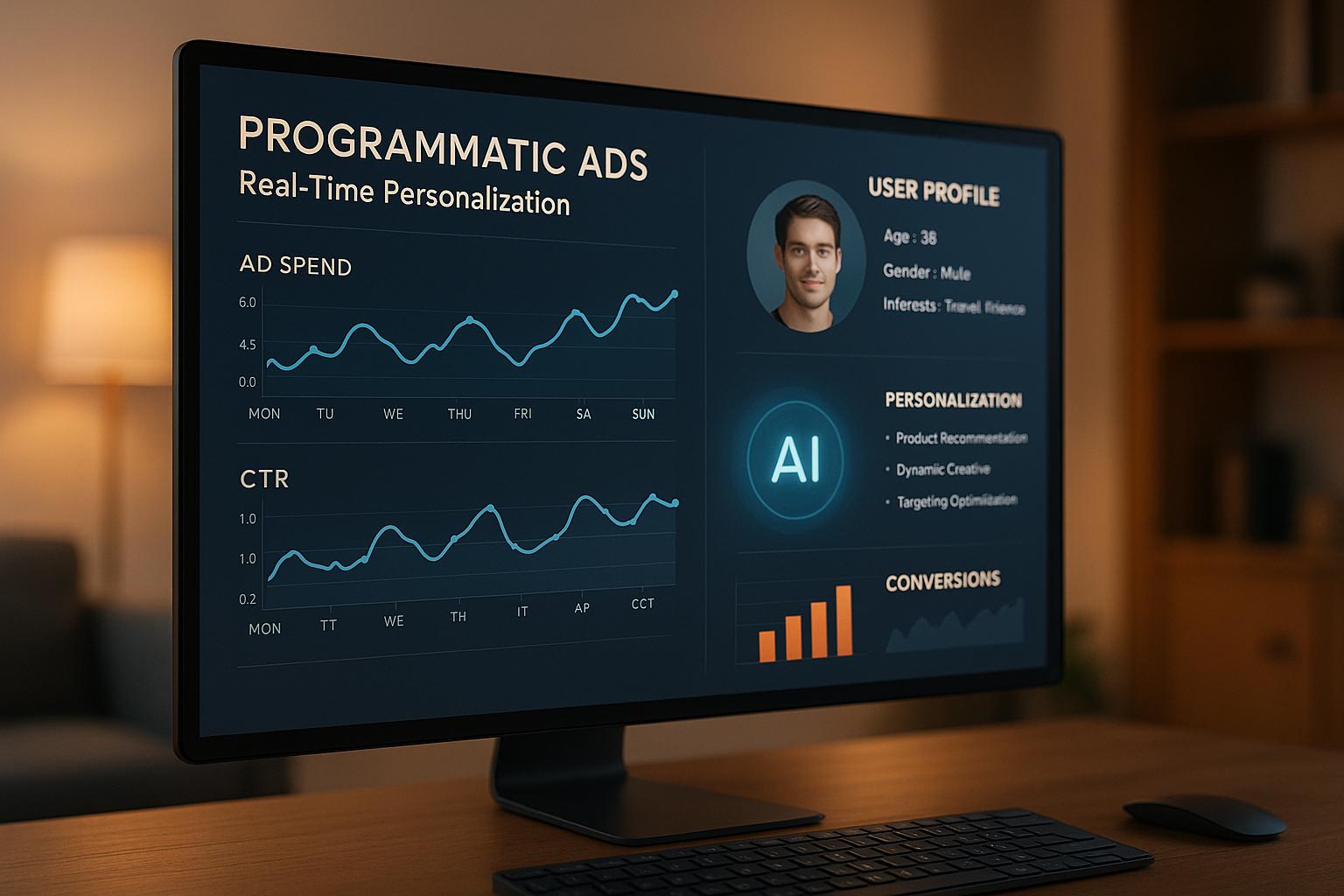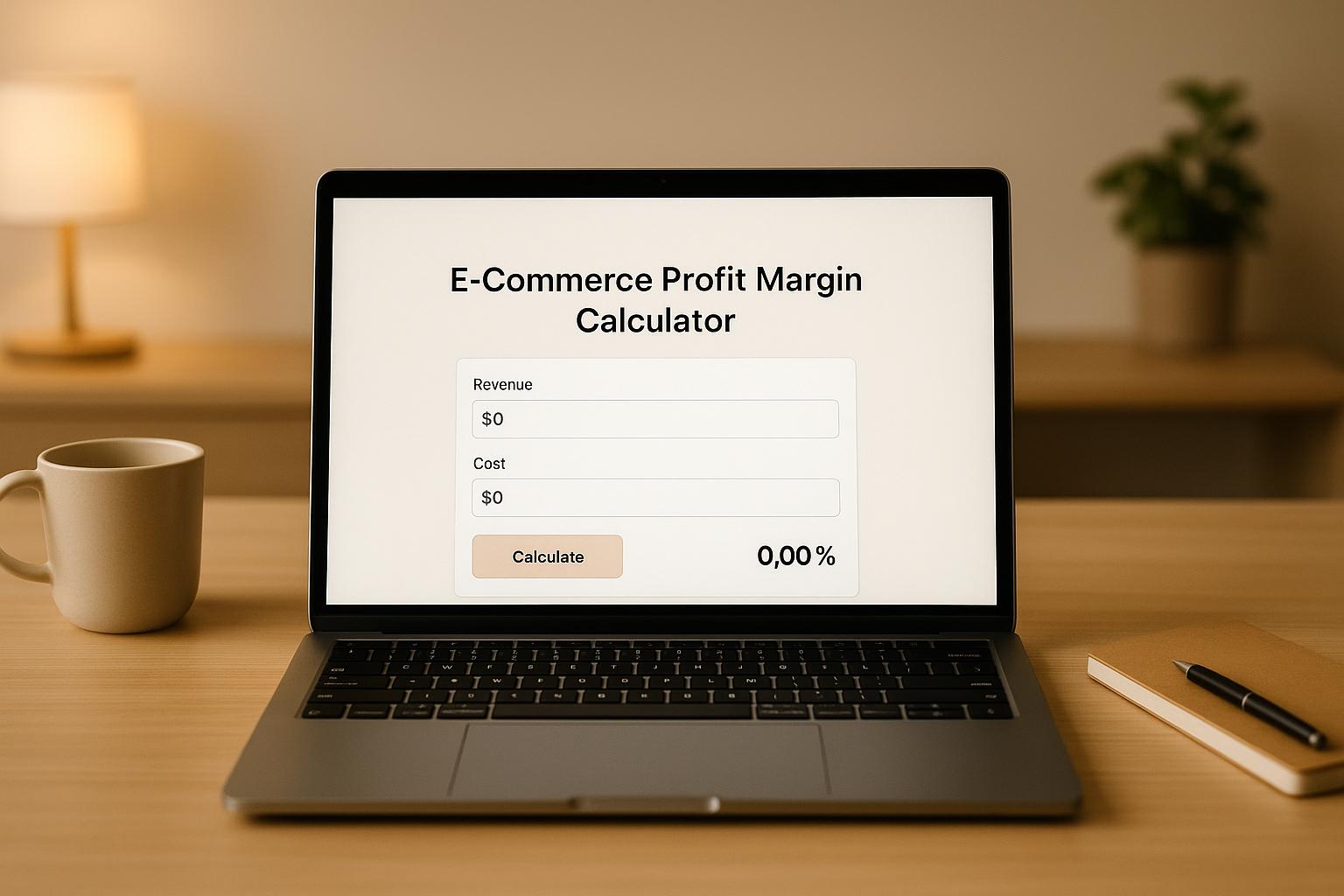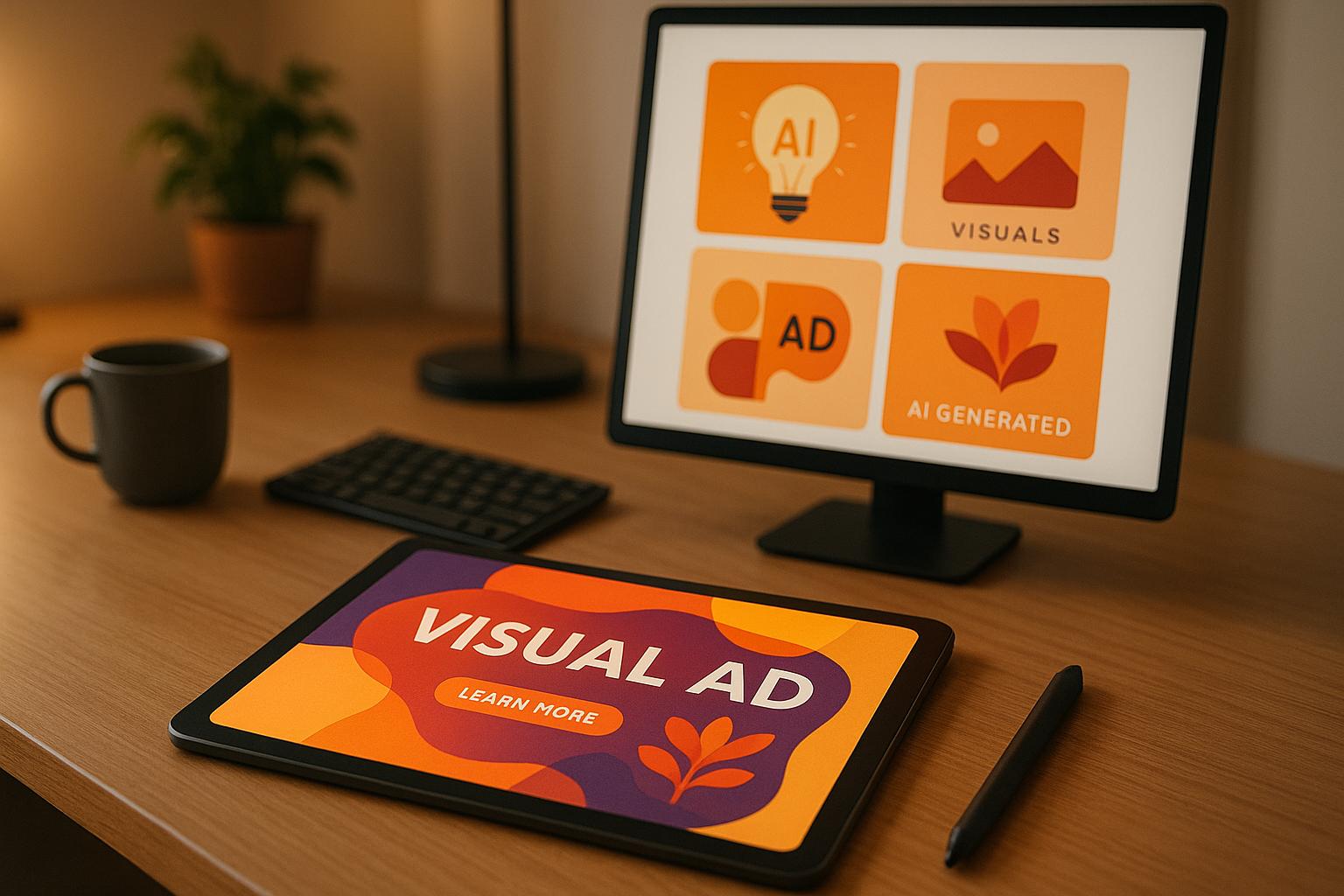AI Tools for Mobile CTR Optimization in E-commerce
Boosting mobile click-through rates (CTR) in e-commerce is all about using AI-powered tools to refine ad strategies, target the right audience, and improve campaign performance. Here’s what you need to know:
- CTR Importance: CTR measures how often people click on your ads. For mobile e-commerce, a CTR between 1.5% and 3% is standard, with top campaigns hitting 4% or more. Even a small increase can drive significant revenue.
- Challenges: Mobile users have shorter attention spans, expect fast-loading pages, and behave differently than desktop users. These factors make optimization tricky.
- AI’s Role: AI tools like Feedcast.ai analyze user behavior, optimize ad copy, and adjust campaigns in real time. They simplify cross-platform management and deliver up to a 30% improvement in CTR.
- Key Metrics: Track CTR percentage, conversion rate, cost per click (CPC), engagement rate, and platform-specific performance to measure success.
- AI Strategies: AI enhances product data, creates tailored ad copy, and dynamically adjusts campaigns based on real-time insights. It also predicts trends and automates reporting for smarter decisions.
Why it matters: With mobile accounting for over half of global web traffic, optimizing mobile campaigns is critical. AI tools not only improve CTR but also reduce costs and increase profitability. Tools like Feedcast.ai centralize campaign management, making it easier to track and improve performance.
Takeaway: AI is transforming mobile CTR optimization. Start by refining product data, testing ad creatives, and using AI analytics to track performance. This approach ensures your campaigns stay competitive in the fast-growing mobile commerce space.
Key Metrics for Mobile CTR Optimization
Mobile CTR Metrics You Need to Track
When it comes to improving your mobile click-through rate (CTR), tracking the right metrics is crucial. Here are the key performance indicators you should monitor:
Click-Through Rate (CTR) Percentage: This is the cornerstone metric, showing the percentage of ad impressions that result in clicks. For e-commerce businesses, a mobile CTR between 1.5% and 3% is considered standard, while top-tier campaigns can hit 4% or more. It's calculated by dividing the number of clicks by the number of impressions[1][2].
Conversion Rate: This tracks what happens after users click - whether they sign up for a newsletter (micro-conversions) or make a purchase (macro-conversions). Considering that 79% of smartphone users regularly shop online[1], keeping an eye on this metric is essential for understanding the effectiveness of your mobile strategy.
Cost Per Click (CPC): Your CPC directly impacts your advertising budget and return on investment. Since click costs vary across platforms, monitoring CPC ensures your budget is being allocated efficiently.
Engagement Rate: This metric digs deeper than clicks, measuring user interactions like time spent on a page, scroll depth, and engagement with product images or videos. Push notifications, for example, boast an average CTR of 28%[1], making them a powerful tool for mobile engagement.
Platform-Specific Performance: CTRs differ by platform. For instance, iOS games average a 4.27% CTR compared to 3.34% on Android, and iOS apps achieve 3.01% versus Android's 2.43%[2]. These variations also extend to geographic regions, so tracking location-based CTRs can uncover opportunities for targeted improvements.
By keeping tabs on these metrics, you build a solid foundation for deeper, AI-powered insights.
Using AI to Analyze Your Metrics
Once you’ve gathered your data, AI tools can take your analysis to the next level, offering insights that go beyond surface-level trends. Here's how AI can help:
Real-Time Data Processing: AI identifies issues like sudden CTR drops as they happen, enabling you to tweak your targeting or ad copy on the fly. This quick response can save your budget and keep your campaigns running smoothly.
Cross-Platform Analysis: Managing data across platforms like Google, Meta, and Microsoft Ads becomes seamless with AI. Tools like Feedcast.ai provide a unified dashboard to compare performance across channels, helping you pinpoint which ones are driving the best CTR for specific products or audiences.
Predictive Analytics: AI doesn’t just analyze the present - it forecasts the future. For example, it can predict how seasonal trends might affect your mobile CTR or highlight product categories that are likely to gain traction, giving you the chance to adjust your campaigns proactively.
Automated Reporting: Custom reports generated by AI simplify data management. These reports can zero in on the metrics that matter most to your mobile strategy, even breaking down performance by device type to reveal differences between mobile and desktop user behavior.
Pattern Recognition: AI uncovers trends that might otherwise go unnoticed. For instance, it might reveal that your mobile CTR spikes at specific times of day or that certain product descriptions consistently perform better on mobile. Platforms like Feedcast.ai can use this information to refine your ad copy, product titles, and descriptions, making them more appealing to mobile shoppers who tend to skim content quickly.
With AI in your corner, you can transform raw data into actionable strategies, ensuring your mobile campaigns are optimized for success.
How to use AI to find and scale winning Facebook Ads
AI-Powered Methods for Mobile CTR Optimization
Now that you know how to track and analyze your mobile CTR metrics, let’s dive into AI-driven strategies that can elevate your campaign performance. These methods take optimization to the next level, leveraging artificial intelligence to craft more engaging ads and connect with the right audience at the right time.
AI Product Data Improvement
Your product data is the backbone of every mobile ad campaign, and AI can transform it into a click-driving powerhouse. By enhancing product titles and descriptions with high-value keywords tailored to platform search habits, AI ensures your listings stand out. For instance, instead of a plain "Blue Shirt", AI might craft something like "Men's Navy Blue Cotton Casual Button-Down Shirt - Slim Fit" - a description that’s far more likely to grab attention.
"Every unoptimized product attribute carries a cost."
- Bryan Falla, Author [4]
Visuals play a huge role too, especially for mobile users who make snap decisions based on what they see. AI can identify and select high-quality images to make a stronger impact. It also refines product categorization using identifiers like GTINs and MPNs, ensuring accuracy and better search results. Accurate product data isn’t just a nice-to-have - it’s essential. Case in point: 35% of Amazon’s revenue comes from its recommendation engine[3].
Platforms like Feedcast.ai take this even further by tailoring product data to each channel’s ranking criteria, ad formats, and user preferences. This includes normalizing and enriching data for better search accuracy and discoverability[5]. By starting with optimized product data, AI can also improve ad copy and targeting strategies, boosting your mobile CTR even more.
Smart Ad Copy Creation and Dynamic Targeting
AI has completely changed how ad copy is written and how mobile audiences are targeted. By analyzing real-time user behavior, AI produces highly personalized ads that resonate on a deeper level. These aren’t just static ads - they’re interactive, adapting based on user engagement. Predictive targeting lets AI anticipate what users might want next, making your marketing efforts more proactive and relevant.
AI-generated ad copy is tailored to each advertising channel, while cross-platform synchronization ensures consistent messaging. Formats and content adjust in real time to maintain relevance. AI also spots creative fatigue - when ads lose their effectiveness - and auto-rotates assets to keep things fresh[6].
Feedcast.ai uses these capabilities to generate personalized ad copy for each platform while its targeting tools help you reach new customers or re-engage existing ones. This dynamic approach keeps your campaigns evolving and effective.
Real-Time Campaign Adjustments with AI
One of AI’s most powerful features is its ability to make real-time adjustments, turning good campaigns into great ones. AI algorithms sift through massive amounts of data to detect patterns, predict outcomes, and refine ad strategies on the fly[8].
For example, automated bidding optimization adjusts bids based on factors like device type, location, time of day, and user intent. This can lead to significant results - advertisers using Google’s Smart Bidding report a 20% increase in conversion value per dollar spent compared to manual bidding[7]. Similarly, Amazon shifted budgets toward trending product categories during the holiday season and saw a 25% sales boost[10].
Location-based targeting is another game-changer, with the potential to double mobile CTR[9]. AI continuously monitors regional performance and adapts to local preferences. Coca-Cola, for example, increased engagement by 20% by reallocating spend based on regional trends[10]. Nike used Adobe Analytics to tweak messaging, resulting in a 30% sales jump within a week[10]. AI also refines audience segmentation, identifying new groups to target automatically. Netflix, for instance, achieved a 15% subscriber growth in regions where it optimized ad spend[10].
Feedcast.ai simplifies all of this with a unified dashboard, giving you a clear view of performance across channels while AI handles the complex adjustments in the background.
How to Use Feedcast.ai for Mobile CTR Optimization

To get started, import your product data and let AI handle the rest. Feedcast.ai simplifies multi-channel advertising by enhancing your data and managing campaigns in a way that aligns with mobile user behavior.
Setting Up Feedcast.ai for Mobile Campaigns
You can import product data directly from popular e-commerce platforms or upload it as a CSV or XML file. Once your data is in the system, Feedcast.ai's AI gets to work. It analyzes your existing product titles and descriptions, then refines them using high-value keywords that align with mobile search habits. Instead of sticking with generic product names, the platform creates optimized titles that grab attention and improve visibility on mobile devices.
Next, connect your advertising accounts. Feedcast.ai integrates seamlessly with Google Ads, Facebook, Instagram, and Microsoft Ads, allowing you to manage all your mobile campaigns from one centralized dashboard. This unified approach saves time, eliminates the hassle of switching between platforms, and ensures your messaging stays consistent across all channels.
The platform also takes care of mobile-specific adjustments, such as bidding strategies, ad formats, and targeting. Once these are in place, you can dive into AI-driven recommendations to fine-tune your campaigns even further.
Using Feedcast.ai's AI Recommendations for Mobile Ads
After your campaigns are set up, Feedcast.ai provides tailored recommendations to help you maximize mobile CTR. The system analyzes product details, audience behavior, and platform trends to craft ad copy that resonates with users on each platform. For example, Google Ads may highlight technical product details, while Instagram ads focus on lifestyle appeal and engaging visuals.
Feedcast.ai’s AI continuously refines audience targeting as your campaigns progress. By analyzing real-time performance data, it identifies which audience segments respond best to your ads and adjusts targeting parameters accordingly. This dynamic targeting system ensures your campaigns evolve and improve without requiring constant manual updates.
"After testing shopping campaigns without much success on my own, I tried Feedcast. Campaigns were quickly set up and the results quickly evolved in a very positive way. Additionally, the support is very responsive to any questions asked!" - Léa Moller, CEO at Nid de Famille [11]
Budget allocation and bidding are also optimized automatically. The AI shifts your budget toward campaigns and keywords that generate the highest mobile CTR, ensuring you get the most out of your ad spend.
When it comes to targeting, Feedcast.ai works on two levels: attracting new customers and retargeting existing ones. For new customer acquisition, the AI identifies lookalike audiences based on your top-performing mobile converters. For retargeting, it creates personalized ads tailored to users’ previous mobile interactions and purchase history.
Tracking Mobile CTR Performance with Feedcast.ai
With Feedcast.ai’s unified dashboard, you can monitor mobile CTR performance across all advertising channels in real time. The dashboard continuously updates, giving you instant access to performance trends and optimization opportunities.
"Unified dashboard for ads performance metrics across various networks is an indispensable tool in the modern digital landscape. It facilitates streamlined analysis, allowing marketers to discern patterns and adjust strategies with heightened agility and precision." - Feedcast.ai [12]
Custom reports allow you to break down performance by device type, platform, product category, and time periods. This detailed view helps you pinpoint which mobile strategies are delivering the best results for different aspects of your business.
Performance segmentation tools uncover hidden insights. For example, you might find that certain product categories perform exceptionally well on mobile during specific times of the day, or that certain ad formats drive higher CTR on mobile compared to desktop. These insights help you make smarter decisions about where to allocate your budget and when to run your campaigns.
The dashboard displays all financial metrics in US dollars ($) with standard formatting, making it easy to track key metrics like return on ad spend and cost per click. You can also compare performance across platforms to identify which channels deliver the best mobile CTR for your products and audience.
Feedcast.ai’s comparative reporting tools make cross-platform analysis simple. You can quickly see how your mobile CTR stacks up on Google Ads, Facebook, and Instagram, and adjust your strategies accordingly. This comprehensive view ensures you’re optimizing your entire advertising ecosystem, not just individual platforms, for the best mobile performance.
sbb-itb-0bd1697
Best Practices for Maintaining High Mobile CTR
Keeping mobile click-through rates (CTR) high requires a thoughtful, data-driven approach that leverages AI to continuously refine and optimize campaigns.
Regular Updates and AI-Enhanced Product Feeds
A well-maintained product feed is the backbone of successful mobile campaigns. With Google Shopping ads driving the bulk of mobile clicks, ensuring your product feed is polished and up-to-date is non-negotiable.
AI tools simplify feed management by automating updates across large catalogs. Instead of manually tweaking hundreds or thousands of product titles and descriptions, AI can generate optimized content in bulk, saving time and ensuring consistency across your listings [13][14]. This is especially useful for seasonal promotions or platform-specific adjustments.
Visuals also play a critical role. High-quality images can boost conversion rates by an impressive 94% [13]. AI tools can standardize image sizes, remove distracting backgrounds, and ensure your visuals meet platform standards, making your ads more appealing to mobile users.
Another game-changer? AI can fill in missing product details like size, color, or material by analyzing existing descriptions and images [14]. Complete and detailed product information helps mobile users make quick buying decisions, directly improving CTR.
Regular updates to your feed are essential. Whether daily or weekly, these updates ensure accurate stock levels, current pricing, and prevent disapprovals [13]. AI monitoring tools can flag errors or inconsistencies, allowing you to fix issues before they hurt campaign performance.
Strategically optimizing your feed not only improves CTR but can also boost return on ad spend (ROAS) and lower cost per click (CPC) [14]. Tools like Feedcast.ai automate these updates, keeping your mobile campaigns running smoothly and efficiently.
Testing and Improving Mobile Ad Creatives
Refreshing your mobile ad creatives regularly is key to combating ad fatigue and keeping engagement high. Studies show that testing ad variations can increase conversion rates by 53.5% [16]. With AI tools, you can quickly create multiple ad versions, saving hours of manual work [17].
To get the best results, test one element at a time - like headlines, images, or call-to-action buttons - while keeping everything else constant. Headlines are particularly important since mobile users often decide within seconds whether to engage with your ad. Experiment with different value propositions, urgency levels, or emotional hooks to see what resonates most.
"Rather than testing many ads and seeing what sticks, we can now identify top-performing creative, copy, landing pages, and more to double down on winners and ditch non-performers." – Ross Campbell, Director of Performance Creative @ AS Beauty [17]
Track metrics like CTR, conversion rates, and engagement to measure performance [16]. AI tools can even predict which creative elements will perform best, helping you make data-informed decisions before committing significant ad spend [15].
For example, Ace Games used AI to fine-tune its creative strategy, resulting in a 52% increase in CTR and a jump in successful creatives from 55% to 80% [21]. This highlights how systematic testing with AI can significantly enhance mobile ad performance.
Pay attention to signs of ad fatigue, such as declining CTR or rising acquisition costs [16]. When these patterns emerge, it’s time to refresh your creatives with updated visuals, messaging, or offers to re-engage your audience. Tools like Feedcast.ai make it easier to test and iterate quickly.
Using Analytics for Continuous Improvement
Analytics are the driving force behind sustained mobile CTR growth. As mobile CTR standards evolve, staying on top of performance data is critical [19].
Monitor key metrics like CTR across devices, times, and audience segments to identify patterns [19]. Effective cost per click (eCPC) is another important metric to ensure your campaigns remain cost-efficient while delivering strong engagement.
Segmenting your data can uncover valuable insights. For example, you might find that certain product categories perform better at specific times of the day or that certain demographics respond more positively to specific ad formats on mobile [18].
In 2023, mobile traffic accounted for 69.7% of all traffic compared to desktop’s 30.3% [20]. This underscores the need for mobile-first strategies. Use analytics to allocate resources effectively and ensure your campaigns align with mobile user behavior.
"We believe the best marketing is where creativity meets data. Data tells us what works; intuition tells us why it matters." – Ran Avrahamy, CMO of AppsFlyer [21]
Regularly reviewing your data helps you adapt to changing trends. For instance, if a particular keyword or ad format starts underperforming, it could signal broader market shifts or platform algorithm changes. AI-powered analytics can detect these trends early, giving you time to adjust before your CTR takes a hit.
Set up automated alerts for significant changes in performance. This proactive approach allows you to act quickly on emerging opportunities or challenges, ensuring your mobile campaigns remain effective and competitive.
Conclusion: Driving Mobile CTR Success with AI
The evolution of mobile Click-Through Rate (CTR) optimization has moved from manual strategies to AI-powered solutions that deliver measurable results. With most brands already incorporating AI tools into their campaigns, adopting these technologies is no longer optional - it's essential to remain competitive.
AI-driven personalization has proven its worth by increasing conversion rates by 15–20% [22], boosting engagement by 68%, and saving significant time - 89% of marketers report saving an hour per campaign launch [24]. This efficiency allows teams to focus on higher-level strategic planning, which is particularly important in mobile commerce, where over 90% of shoppers feel the mobile experience could be better [24].
The financial benefits are equally compelling. AI has the potential to cut customer acquisition costs by up to 50% [22] and increase profitability by up to 25% [23]. Additionally, AI's forecasting capabilities can reduce inventory costs by as much as 75% [22].
"AI will slash the cost of entry to marketing and ad campaigns. … Having an assistant who understands your business and helps design, execute, and tweak strategy is a massive power-up. With access to your business data and tools, it becomes a marketing expert wired into your systems - a superpower."
– Alex Pilon, Shopify Senior Developer [25]
Tools like Feedcast.ai highlight how AI can simplify campaign management and improve performance. By refining product feeds and optimizing ad copy, Feedcast.ai centralizes campaign oversight across major platforms. Its unified dashboard offers real-time insights, enabling businesses to identify trends and make proactive adjustments to their strategies.
As mobile commerce continues to expand, AI isn't just a tool - it's a necessity. Start small with low-cost AI solutions and measure their impact [26]. Focus on areas that need the most improvement, whether that's enhancing product data, testing ad creatives, or analyzing performance metrics. Choose tools that integrate smoothly with your existing systems to maximize efficiency.
With nearly 80% of companies already using AI in at least one business function [26], the question is no longer if AI will reshape mobile CTR optimization, but whether your business will lead the charge or risk falling behind competitors who move faster. Now is the time to embrace AI-powered strategies and secure your place in the future of mobile commerce.
FAQs
How can AI tools like Feedcast.ai optimize product data to boost mobile CTR for e-commerce businesses?
AI tools like Feedcast.ai take the hassle out of refining product data by automating improvements to essential details like product titles, descriptions, and attributes. Powered by advanced AI, these tools fine-tune product information to make it more appealing and relevant, especially for mobile users. This ensures ads grab attention and encourage clicks.
By boosting product visibility and aligning content more closely with what users are searching for, these tools help e-commerce businesses achieve higher click-through rates (CTR) on mobile devices. The payoff? Ads that perform better and customers who are more engaged.
What are the most important metrics for improving mobile click-through rates (CTR), and how can AI help optimize them?
Key Metrics for Improving Mobile CTR
When it comes to boosting mobile click-through rates (CTR), there are a few key metrics to keep an eye on: CTR itself, impressions, clicks, and engagement rates. These numbers tell you how well your ads are grabbing attention and keeping users interested.
AI plays a powerful role in optimizing CTR by analyzing these metrics in real time. It can spot patterns and trends you might miss, using predictive modeling and advanced targeting to zero in on the right audience. By refining ad placements and sharpening your messaging, AI helps create campaigns that perform better and deliver stronger results for your e-commerce business.
How do AI-powered real-time adjustments improve mobile ad performance?
How AI Enhances Mobile Ad Performance
AI-driven real-time adjustments can take mobile ad performance to a whole new level by fine-tuning bids, budgets, and audience targeting based on live data. These instant tweaks ensure your ads reach the right people at the right moment, increasing engagement and driving higher click-through rates (CTR).
By automating these tasks, businesses can cut down on wasted ad spend, improve return on investment (ROI), and design campaigns that align with user behavior and preferences - all without the need for constant manual effort.
Geoffrey G.




